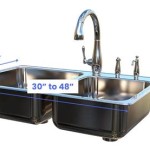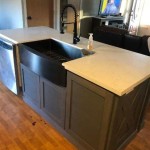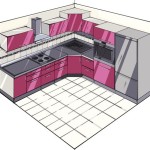The Practical Elegance of Small Rugs for Kitchen Sinks
Kitchens, the heart of many homes, are spaces subjected to significant foot traffic and moisture. One area particularly vulnerable is the space in front of the kitchen sink. This area experiences frequent water splashes, spills, and general wear and tear. Consequently, incorporating a small rug designed specifically for this area can offer numerous practical and aesthetic benefits. The strategic placement of a small rug near the kitchen sink can significantly improve safety, comfort, and the overall look and feel of the kitchen.
Key Points:
Enhanced Safety and Spill Containment
The primary function of a small rug near the kitchen sink is to enhance safety. Kitchen floors, often made of tile, linoleum, or wood, can become slippery when wet. Water splashes from washing dishes or rinsing vegetables can create a hazardous environment, increasing the risk of slips and falls. A rug, especially one with a non-slip backing, provides a more secure surface underfoot. This is particularly important for households with children, elderly individuals, or anyone prone to mobility issues.
Furthermore, a small rug acts as a spill containment barrier. It absorbs minor spills and splashes, preventing water from spreading across the kitchen floor. This not only reduces the risk of slipping but also protects the flooring from potential water damage. Prolonged exposure to moisture can warp wooden floors, damage grout in tiled floors, and degrade the adhesive used in linoleum flooring. By absorbing spills, the rug helps maintain the integrity and longevity of the kitchen flooring.
The absorbency of the rug material is a critical factor. Materials such as cotton, microfiber, and certain synthetic fibers are highly absorbent and quickly soak up water. These materials are advantageous in mitigating the risks associated with spills. Regular cleaning of the rug is essential to maintain its absorbency and prevent the growth of mold or mildew. Rugs with waterproof or water-resistant backing offer an additional layer of protection, preventing moisture from seeping through to the underlying floor.
Beyond water, the rug can also catch food particles and grease splatters that often occur during food preparation and dishwashing. This containment prevents these substances from being tracked across the kitchen and into other areas of the house. A small rug is easier to clean than the entire kitchen floor, making it a more manageable and efficient solution for maintaining cleanliness.
Added Comfort and Ergonomic Support
Standing for extended periods while washing dishes or preparing food can put strain on the feet, legs, and back. Kitchen floors, particularly those made of hard materials like tile or concrete, offer little cushioning and can exacerbate discomfort. A small rug, especially one with padding or a cushioned construction, provides a more comfortable surface to stand on, reducing fatigue and strain.
The cushioning effect of the rug helps to distribute weight more evenly, relieving pressure points and improving circulation. This is particularly beneficial for individuals who suffer from foot pain, back pain, or arthritis. The added comfort can make kitchen tasks more enjoyable and less physically demanding.
Ergonomic kitchen mats or rugs are specifically designed to provide optimal support and cushioning. These mats often feature a thick, resilient core made of materials such as memory foam or gel. The contoured surface can further enhance comfort by providing targeted support to the arches of the feet. Investing in an ergonomic rug or mat can significantly improve the overall comfort and well-being of individuals who spend a considerable amount of time standing in the kitchen.
The texture of the rug can also contribute to comfort. A soft, plush rug can feel pleasant underfoot, providing a tactile sensation that enhances the overall experience of being in the kitchen. However, it is important to choose a rug with a texture that is easy to clean and does not trap dirt or debris. Low-pile rugs are generally easier to maintain and are less likely to become matted or worn over time.
Enhancing Kitchen Aesthetics
In addition to its practical benefits, a small rug near the kitchen sink can significantly enhance the aesthetic appeal of the kitchen. A well-chosen rug can add a splash of color, introduce pattern and texture, and tie together the overall design scheme of the space. The rug serves as a focal point, drawing the eye and adding visual interest to what might otherwise be a functional but unremarkable area.
The selection of a rug should complement the existing color palette and style of the kitchen. If the kitchen features neutral colors, a rug with a bold pattern or vibrant color can add a pop of personality. Conversely, if the kitchen is already colorful and patterned, a more subtle and understated rug may be a better choice. Considerations should be given to the kitchen’s design style; for example, a traditional kitchen might benefit from a rug with a classic motif, while a modern kitchen might be better suited to a rug with a geometric pattern or minimalist design.
The material and texture of the rug can also contribute to the overall aesthetic. A natural fiber rug, such as jute or sisal, can add a rustic or organic touch to the kitchen. A synthetic rug, such as nylon or polyester, can offer a more contemporary and durable option. The texture of the rug can add visual interest and depth to the space. A high-pile shag rug can feel luxurious underfoot, while a low-pile flatweave rug can offer a more streamlined and modern look.
Moreover, the size and shape of the rug should be carefully considered. A rug that is too small may look insignificant, while a rug that is too large may overwhelm the space. The shape of the rug should complement the layout of the kitchen and the placement of the sink. A rectangular rug is a common choice for a standard kitchen sink, while a circular or oval rug can add a softer and more organic touch. Runners are often utilized for galley kitchens, allowing for a seamless transition between the sink and adjacent areas.
Material Considerations
The choice of material for a kitchen sink rug is paramount, influencing its durability, absorbency, ease of cleaning, and overall aesthetic. Various materials offer distinct advantages and disadvantages, making careful consideration crucial for selecting the most suitable option.
Cotton rugs are known for their softness, absorbency, and natural feel. Cotton is a relatively inexpensive material, making it a budget-friendly option. However, cotton rugs can be prone to staining and fading, and they may not be as durable as some synthetic options. Regular washing is necessary to maintain their cleanliness and appearance.
Microfiber rugs, typically made from polyester or nylon fibers, are highly absorbent, quick-drying, and stain-resistant. Microfiber is a durable material that can withstand frequent washing and heavy use. Microfiber rugs are also relatively inexpensive, making them a popular choice for kitchens. They are easy to clean and maintain, often requiring only a quick vacuum or wipe-down.
Nylon rugs are exceptionally durable and resistant to abrasion, stains, and fading. Nylon is a synthetic fiber that can withstand heavy foot traffic and frequent washing. Nylon rugs are a good choice for high-traffic kitchens where durability is a primary concern. However, nylon rugs can be more expensive than cotton or microfiber rugs.
Polyester rugs share many of the characteristics of nylon rugs, including durability, stain resistance, and fade resistance. Polyester is a synthetic fiber that is often less expensive than nylon, making it a more budget-friendly option for durable rugs. Polyester rugs are easy to clean and maintain, and they are available in a wide range of colors and patterns.
Jute and sisal rugs offer a natural and textured look that can add a rustic or organic touch to the kitchen. These natural fibers are durable and relatively easy to clean, but they can be less absorbent than cotton or microfiber. Jute and sisal rugs are best suited for kitchens with minimal spills and splashes.
Memory foam rugs provide exceptional cushioning and comfort, making them a good choice for individuals who spend a lot of time standing at the kitchen sink. Memory foam conforms to the shape of the feet, providing support and reducing pressure points. However, memory foam rugs can be more expensive than other options, and they may not be as durable or easy to clean.
Maintenance and Cleaning
Proper maintenance is crucial for extending the life and maintaining the appearance of a small rug placed near the kitchen sink. Regular cleaning not only prevents the buildup of dirt and stains but also inhibits the growth of mold and mildew, ensuring a hygienic environment.
Vacuuming the rug regularly is essential for removing loose dirt, crumbs, and debris. A vacuum cleaner with a brush attachment is ideal for lifting dirt from the fibers of the rug. Vacuuming frequency should be increased in high-traffic kitchens or in households with pets.
Spot cleaning is necessary for addressing spills and stains as soon as they occur. Blot the spill with a clean, absorbent cloth, working from the outside in to prevent the stain from spreading. Avoid rubbing the stain, as this can push it deeper into the fibers of the rug. Use a mild detergent or stain remover specifically designed for rugs. Test the cleaning solution on an inconspicuous area of the rug before applying it to the stain.
Machine washing is possible for many small rugs, particularly those made of cotton, microfiber, or polyester. Check the manufacturer's instructions for specific washing guidelines. Use a gentle cycle and cold water to prevent shrinking or fading. Tumble dry on low heat or hang the rug to air dry. Avoid using bleach or harsh chemicals, as these can damage the fibers of the rug.
Professional cleaning is recommended for rugs that are heavily soiled or stained, or for rugs made of delicate materials. Professional rug cleaners have the expertise and equipment to safely and effectively clean a wide range of rug types. They can also provide specialized treatments for stain removal and odor control.
Rotating the rug periodically can help to distribute wear evenly and prevent fading in areas exposed to sunlight. Flip the rug over occasionally to allow the underside to air out and prevent moisture buildup. Use a rug pad underneath the rug to protect the flooring and prevent the rug from slipping.
Non-Slip Backing Considerations
The selection of a small rug for the kitchen sink necessitates careful consideration of the backing material. The primary function of the backing is to prevent the rug from slipping or sliding on the floor, thereby enhancing safety and minimizing the risk of accidents. Several types of non-slip backing are available, each offering varying degrees of effectiveness and durability.
Latex backing is a common and relatively inexpensive option. Latex provides good grip on most types of flooring, including tile, linoleum, and wood. However, latex can degrade over time, particularly when exposed to heat or sunlight. Latex backing may also not be suitable for individuals with latex allergies.
Rubber backing offers excellent grip and durability. Rubber is resistant to wear and tear and can withstand frequent washing. Rubber backing is a good choice for high-traffic kitchens where slip resistance is a primary concern. However, rubber backing can be more expensive than latex backing.
Gel backing is a newer option that provides excellent grip and cushioning. Gel backing is made of a soft, flexible material that conforms to the shape of the floor, providing a secure and comfortable surface. Gel backing is also resistant to water and stains, making it a good choice for kitchens. However, gel backing can be more expensive than latex or rubber backing.
Thermo-plastic rubber (TPR) backing is a synthetic alternative to natural rubber. TPR offers good grip and durability, and it is resistant to water and chemicals. TPR backing is a good choice for individuals who are allergic to natural rubber. TPR backing is also recyclable, making it a more environmentally friendly option.
Adhesive rug pads provide an alternative to rugs with integrated non-slip backing. These pads are placed underneath the rug and adhere to both the rug and the floor, preventing slippage. Adhesive rug pads can be used with any type of rug, and they can be easily removed and replaced as needed. However, adhesive rug pads may leave a residue on the floor when removed.

Sixhome Kitchen Mat 23 6 X39 4 Rugs Non Skid Twill Floor Mats Washable Small Throw Rug For In Front Of Sink Brown Beige

Sixhome Kitchen Rugs Non Slip Washable Mat Absorbent Floor Mats Rubber Backed Small For Front Of Sink 20 Inchx32 Inch

Sixhome Kitchen Rugs Non Slip Washable Mat Absorbent Floor Mats Rubber Backed Small For Front Of Sink 20 Inchx32 Inch

Small Round Vinyl Area Rug Kitchen Floor Red Flower Circle Mat Anti Slip Linoleum Etsy

Sixhome Kitchen Mat 23 6 X39 4 Rugs Non Skid Twill Floor Mats Washable Small Throw Rug For In Front Of Sink Brown Beige

Lufeijiashi Small Kitchen Rugs And Mats Non Skid Washable Runner Rug Absorbent Farmhouse Style Floor For In Front Of Sink Light

Boho Bathroom Rug Washable 2x3 Small Bath Mat Vintage Soft Kitchen Sink Ebay

Lufeijiashi Small Kitchen Rugs And Mats Non Skid Washable Runner Rug Absorbent Farmhouse Style Floor For In Front Of Sink Light

Kitchen Rugs 2 Piece Waterproof Non Slip Rug Set For Sink Office Cafe Small Colorful Flowers

How To Choose The Perfect Kitchen Rug Décor Aid








